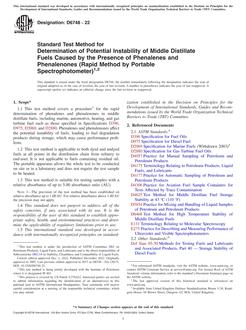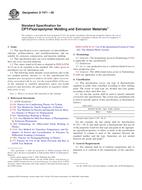1.1 These test methods cover the chemical analysis of stainless, heat-resisting, maraging, and other similar chromium-nickel-iron alloys having chemical compositions within the following limits:
| Element | Concentration Range, % | |
| Aluminum | 0.002 | to 5.50 |
| Boron | 0.001 | to 0.20 |
| Carbon | 0.01 | to 1.50 |
| Chromium | 0.01 | to 35.00 |
| Cobalt | 0.01 | to 15.00 |
| Columbium (Niobium) | 0.01 | to 4.00 |
| Copper | 0.01 | to 5.00 |
| Lead | 0.001 | to 0.50 |
| Manganese | 0.01 | to 20.00 |
| Molybdenum | 0.01 | to 7.00 |
| Nickel | 0.01 | to 48.00 |
| Nitrogen | 0.001 | to 0.50 |
| Phosphorus | 0.002 | to 0.35 |
| Selenium | 0.01 | to 0.50 |
| Silicon | 0.01 | to 4.00 |
| Sulfur | 0.002 | to 0.50 |
| Tantalum | 0.01 | to 0.80 |
| Tin | 0.001 | to 0.05 |
| Titanium | 0.01 | to 4.50 |
| Tungsten | 0.01 | to 4.50 |
| Vanadium | 0.005 | to 1.00 |
| Zirconium | 0.001 | to 0.20 |
1.2 The test methods in this standard are contained in the sections indicated below:
| Sections | |
| Aluminum, Total, by the 8-Quinolinol Gravimetric Method (0.20 to 7.00 %) | 119 |
| Aluminum, Total, by the 8-Quinolinol Photometric Method (0.003 to 0.20 %) | 71 |
| Carbon, Total, by the Combustion-Thermal Conductivity Method | 2a |
| Carbon, Total, by the Combustion Gravimetric Method (0.05 to 1.50 %) | 98 |
| Chromium by the Atomic Absorption Method (0.006 to 1.00 %) | 202 |
| Chromium by the Peroxydisulfate Oxidation-Titration Method (0.10 to 35.00 %) | 212 |
| Chromium by the Peroxydisulfate-Oxidation Titrimetric Method | 2b |
| Cobalt by the Ion-Exchange-Potentiometric Titration Method (2 to 15. %) | 53 |
| Cobalt by the Nitroso-R-Salt Photometric Method (0.01 to 5.0 %) | 61 |
| Copper by the Neocuproine Photometric Method (0.01 to 5.00) %) | 109 |
| Copper by the Sulfide Precipitation-Electrodeposition Gravimetric Method (0.01 to 5.00 %) | 82 |
| Lead by the Ion-Exchange-Atomic Absorption Method (0.001 to 0.50 %) | 127 |
| Manganese by the Periodate Photometric Method (0.01 to 5.00 %) | 8 |
| Molybdenum by the Ion Exchange-8-Hydroxyquinoline Gravimetric Method | 242 |
| Molybdenum by the Photometric Method (0.01 to 1.50 %) | 190 |
| Nickel by the Dimethylglyoxime Gravimetric Method (0.1 to 48.0 %) | 172 |
| Phosphorus by the Alkalimetric Method (0.02 to 0.35 %) | 164 |
| Phosphorus by the Molybdenum Blue Photometric Method (0.002 to 0.35 %) | 18 |
| Silicon by the Gravimetric Method (0.05 to 4.00 %) | 46 |
| Sulfur by the Gravimetric Method | 2c |
| Sulfur by the Combustion-Iodate Titration Method (0.005 to 0.5 %) | 37 |
| Sulfur by the Chromatographic Gravimetric Method | 2b |
| Tin by the Solvent Extraction-Atomic Absorption Method (0.002 to 0.10 %) | 180 |
| Tin by the Sulfide-Iodometric Titration Method (0.01 to 0.05 %) | 90 |
| Titanium, Total, by the Diantipyrylmethane Spectrophotometric Method (0.01 to 0.35 %) | 231 |
| Vanadium by the Atomic Absorption Method (0.006 to 0.15 %) | 221 |
1.3 Test methods for the determination of several elements not included in this standard can be found in Test Methods E30 and Test Methods E1019.
1.4 Some of the concentration ranges given in 1.1 are too broad to be covered by a single test method and therefore this standard contains multiple test methods for some elements. The user must select the proper test method by matching the information given in the Scope and Interference sections of each method with the composition of the alloy to be analyzed.
1.5 The values stated in SI units are to be regarded as standard. In some cases, exceptions allowed in Practice E380 are also used.
1.6 This standard does not purport to address all of the safety concerns, if any, associated with its use. It is the responsibility of the user of this standard to establish appropriate safety and health practices and determine the applicability of regulatory limitations prior to use. Specific hazards statements are given in Section 5 and in special “Warning” paragraphs throughout these test methods.
Product Details
- Published:
- 01/01/2000
- Number of Pages:
- 33
- File Size:
- 1 file , 270 KB


